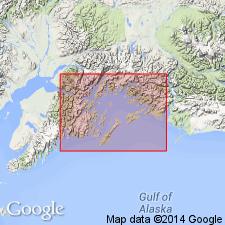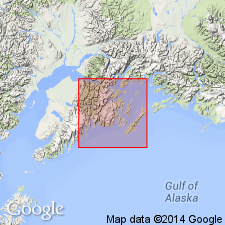
- Usage in publication:
-
- Cedar Bay granite*
- Modifications:
-
- Named
- Dominant lithology:
-
- Granite
- AAPG geologic province:
-
- Alaska Southern region
Summary:
Cedar Bay granite surrounds two-thirds of Cedar Bay which is main eastern arm of Wells Bay, north-central part of Prince William Sound, southern AK. Also forms core of neck of land between Wells Bay and passage northwest of Glacier Islands. Extends well up into head of northeast arm of Wells Bay. Is light-gray, even-grained granite. Occurs in granitoid phase and a white porphyry with microgranitic groundmass. Intrudes Valdez group of probable Paleozoic age. [Age is Mesozoic(?).]
Source: GNU records (USGS DDS-6; Menlo GNULEX).

- Usage in publication:
-
- Cedar Bay Granite*
- Modifications:
-
- Age modified
- Geochronologic dating
- AAPG geologic province:
-
- Alaska Southern region
Summary:
Intrudes slate and sandstone of Orca Group. Samples plotted in potassium-rich part of granite field, in alkali-feldspar granite field and in tonalite field (marginal part). K-Ar age on hornblende yielded 41.3 Ma and on coexisting biotite, 51.9 Ma from Sheep Bay body which is very similar chemically to Cedar Bay Granite (Plafker, George, oral commun., 1977). On chemical basis Cedar Bay Granite is considered to be probable Eocene(?) age.
Source: GNU records (USGS DDS-6; Menlo GNULEX).
For more information, please contact Nancy Stamm, Geologic Names Committee Secretary.
Asterisk (*) indicates published by U.S. Geological Survey authors.
"No current usage" (†) implies that a name has been abandoned or has fallen into disuse. Former usage and, if known, replacement name given in parentheses ( ).
Slash (/) indicates name conflicts with nomenclatural guidelines (CSN, 1933; ACSN, 1961, 1970; NACSN, 1983, 2005, 2021). May be explained within brackets ([ ]).

